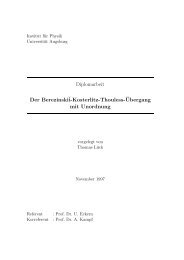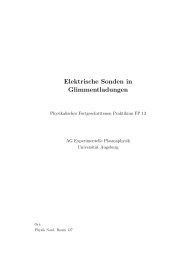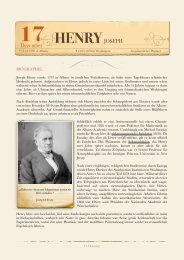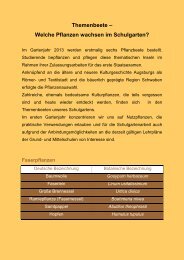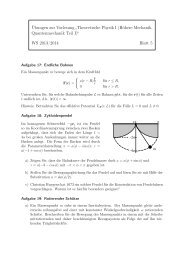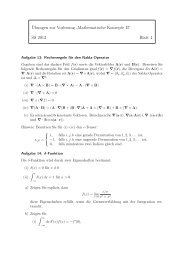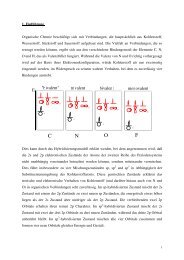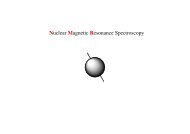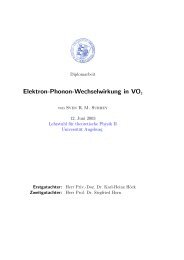Driven Quantum Systems - Institut für Physik
Driven Quantum Systems - Institut für Physik
Driven Quantum Systems - Institut für Physik
You also want an ePaper? Increase the reach of your titles
YUMPU automatically turns print PDFs into web optimized ePapers that Google loves.
262 <strong>Driven</strong> <strong>Quantum</strong> <strong>Systems</strong><br />
yielding<br />
{<br />
i¯h ˙Ψ(y, t) = i¯h ˙ζ ∂<br />
∂y − ¯h2 ∂ 2<br />
2m ∂y + 1 }<br />
2 2 mω2 0 (y + ζ)2 − (y + ζ)S(t) Ψ(y, t). (5.68)<br />
Performing the unitary transformation<br />
with ζ(t) obeying the classical equation of motion,<br />
Ψ(y,t) =exp{−im ˙ζy/¯h}φ(y, t), (5.69)<br />
m¨ζ + mω0 2 ζ = S(t), (5.70)<br />
the term linear in y vanishes to yield<br />
{−¯h2<br />
i¯h ˙φ(y,t) ∂ 2<br />
=<br />
2m∂y + 1 }<br />
2 2 mω2 0y 2 + L(ζ, ˙ζ,t) φ(y, t). (5.71)<br />
Here, L(ζ, ˙ζ,t) is the classical Lagrangian of a driven oscillator,<br />
L = 1 2 m ˙ζ 2 − 1 2 mω2 0ζ 2 + ζS(t). (5.72)<br />
Another unitary transformation<br />
{ ∫ t<br />
φ(y,t) =exp −i dt ′ L(ζ, ˙ζ,t<br />
}<br />
′ ) χ(y, t) (5.73)<br />
0<br />
reduces the starting equation to the well-known Schrödinger equation of a stationary<br />
harmonic oscillator,<br />
{−¯h2 ∂ 2<br />
i¯h ˙χ(y,t) =<br />
2m∂y + 1 }<br />
2 2 mω2 0y 2 χ(y, t). (5.74)<br />
In terms of the eigenvalues E n = ¯hω 0 (n +1/2), and the well-known harmonic<br />
eigenfunctions ϕ n , being proportional to the Hermite functions, the solutions of (5.66)<br />
are of the form<br />
{ [ ī<br />
Ψ n (x, t) =ϕ n (x−ζ(t)) exp m<br />
h<br />
˙ζ(t)(x<br />
∫ t ]}<br />
− ζ(t)) − E n t + dt ′ L . (5.75)<br />
0<br />
The set {ϕ n (x)} forms a complete set in R; thus any general solution Ψ(x, t) canbe<br />
expanded in terms of the solutions in (5.75). Next we consider the restriction to a<br />
periodic monochromatic drive<br />
A periodic solution ζ φ of (5.70) reads<br />
S(t) =Ssin(ωt + φ), ω ≠ ω 0 . (5.76)<br />
mζ φ (t) =Ssin(ωt + φ)/(ω 2 0 − ω2 ). (5.77)



